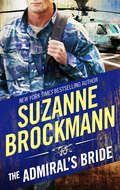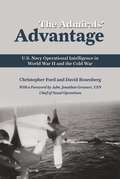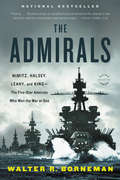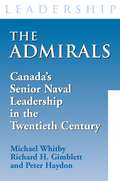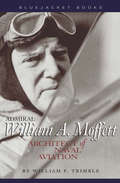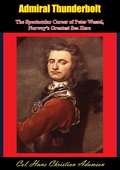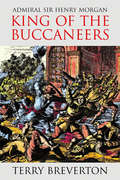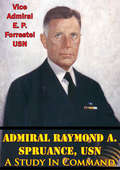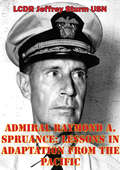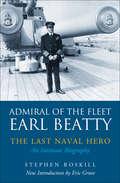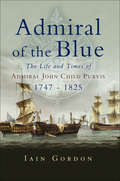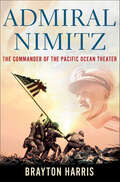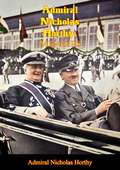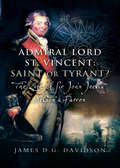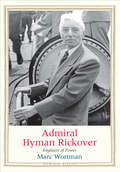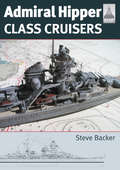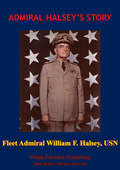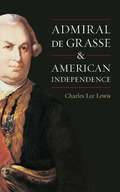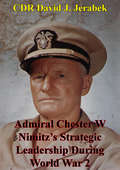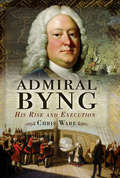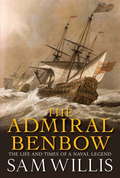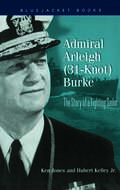- Table View
- List View
The Admiral's Bride
by Suzanne BrockmannNew York Times and USA TODAY bestselling author Suzanne Brockmann has thrilled audiences with her Tall, Dark and Dangerous series. Experience it here with a hero who must face the most daring adventure of all--falling in love. Now everything is on the line... When six canisters of a lethal nerve agent are stolen from a military testing lab, it's up to Admiral Jake Robinson to infiltrate the compound where religious fanatics have stored the deadly toxin. His partner--posing as his wife--is Dr. Zoe Lange, a biological warfare specialist and an expert in espionage. And though their marriage may be a hoax, Jake's growing feelings for Zoe are anything but make-believe. With each hour he's in Zoe's company the stakes get higher, and the situation within the compound is escalating...
The Admirals' Advantage
by Christopher Ford David RosenbergThis analytic and historical study provides a revealing look at naval operational intelligence by embracing the fundamental question of what OPINTEL is and how it answers the fundamental question "Where is the enemy, in what strength, and disposition, and what is he doing right now?" It is primarily the result of an Operational Intelligence Lessons-Learned Symposium held at the National Maritime Intelligence Training Center in Dam Neck, Virginia, 12-13 September 1998. The participants included senior intelligence professionals whose mandate was to explore the ramifications of the evolution of naval operational intelligence since World War II. Current practices were also explored with inputs from current practitioners as represented by various fleet and shore commands. Additional sources for the study were oral interviews and correspondence with senior members of the intelligence community. The authors have scrupulously taken the work as close to the edge of security classification as is possible to enhance its value without being damaging to national security.
The Admirals: Nimitz, Halsey, Leahy, and King--The Five-Star Admirals Who Won the War at Sea
by Walter R. BornemanHow history's only five-star admirals triumphed in World War II and made the United States the world's dominant sea power. Only four men in American history have been promoted to the five-star rank of Admiral of the Fleet: William Leahy, Ernest King, Chester Nimitz, and William Halsey. These four men were the best and the brightest the navy produced, and together they led the U. S. navy to victory in World War II, establishing the United States as the world's greatest fleet. In THE ADMIRALS, award-winning historian Walter R. Borneman tells their story in full detail for the first time. Drawing upon journals, ship logs, and other primary sources, he brings an incredible historical moment to life, showing us how the four admirals revolutionized naval warfare forever with submarines and aircraft carriers, and how these men-who were both friends and rivals-worked together to ensure that the Axis fleets lay destroyed on the ocean floor at the end of World War II.
The Admirals: Canada's Senior Naval Leadership in the Twentieth Century
by Michael Whitby Richard H. Gimblett Peter HaydonThe Admirals: Canada’s Senior Naval Leadership in the Twentieth Century fills an important void in the history of Canada’s navy. Those who carry the burden of high command have a critical niche in not only guiding the day-to-day concerns of running an armed service but in ensuring that it is ready to face the challenges of the future. Canada’s leading naval historians present analytical articles on the officers who led the navy from its foundation in 1910 to the unification in 1968. Six former Maritime Commanders provide personal reflections on command. The result is a valuable biographical compendium for anyone interested in the history of the Canadian Navy, the Canadian Forces, or military and naval leadership in general.
Admiral William A. Moffett
by William F. TrimbleNaval aviation historian William F. Trimble provides a clear and detailed portrait of the man who took on the challenge of forming an aeronautical bureau within the U.S. Navy in 1921 and then nurtured the early development of naval aviation. Describing Admiral William A. Moffett as one of the first high-ranking naval officers to appreciate the importance of the airplane and the effect it would have on the fleet, the author contends that the admiral's strong background as a surface officer gave him a credibility and trust with his superiors that others could not match. The author attributes Moffett's desire to keep aviation as part of the fleet, along with his diplomacy, tenacity, and political and military savvy, to the success of the infant air arm during its formative years. In striking contrast to the tactics of Army General Billy Mitchell, Moffett's handling of the loyalty issue and other politically sensitive topics saved the Navy's air arm, according to Trimble. The book is equally candid about the admiral's shortcomings, including his heavy-handed support for airships, a technological dead end that squandered millions and led to Moffett's death in 1933 when he went down with the airship Akron during a storm.
Admiral Thunderbolt: The Spectacular Career of Peter Wessel, Norway’s Greatest Sea Hero
by Col. Hans Christian Adamson“A Sea Cadet in 1711 and a Vice Admiral in 1718, young Wessel barged into battle against his Swedish foes wherever he found them, often in direct violation of orders issued by timid souls in the Admiralty. But Frederik IV, King of Denmark-Norway, loved a winner. He gave his youthful fighting cock promotion after promotion, over scores of officers of senior vintage. The result was that Peter had almost as many enemies among officers in the Danish-Norwegian Navy as he had in that of Sweden.“So great were his battle conquests and his services to the nation that Captain Wessel, soon after his twenty-fifth birthday, was given a Patent of Nobility and the name Tordenskjold. Roughly translated, this means (Torden) The Thunderbolt that Strikes and (Skjold) The Shield that Defends. In actions on land and sea, Tordenskjold lifted his nom de guerre to deathless and stratospheric heights.“While this book is based on historical events and peopled by real persons, it is by no means a definitive history. The Great Northern War, which ran from 1709 to 1719, sucked Denmark-Norway, Russia, Poland, and England into conflict against the then mighty Sweden. Its pattern is too complicated for compression into a one-volume book dedicated to pinpointing the career of a single participant. For that matter, the historical facts, folklore, and legends that have been built up over the centuries around Vice Admiral Peter Tordenskjold are so voluminous that, in themselves, they could cover quite a spread of bookshelf! The problem has not been what to put into this book, but what to leave out and still do justice to its subject.”
Admiral Sir Henry Morgan: King of the Buccaneers
by Terry BrevertonDiscover the truth about the 17th-century Welsh naval officer who became a hero for the British Empire—and not a bloodthirsty pirate.This is the swashbuckling biography of the naval officer known as the Sword of England, the Welshman Henry Morgan. Over the years, Morgan came to be portrayed as a black-hearted, fierce pirate. This error in terms and in the assessment of Morgan’s character led to the filing of the first libel lawsuit, brought in protest to a book published in 1684 claiming he had been an indentured servant, was a pirate, and was responsible for atrocities. In fact, Morgan was commissioned to aid the British navy in fighting enemies of the crown and was a superb military tactician who led a dozen victorious campaigns against massive odds.In 1655, Spain was the greatest naval and military power on earth, and controlled the sea lanes of Central America and the Caribbean. Henry Morgan’s career as a buccaneer officially began when, at age twenty, he landed in Barbados as part of a force deployed to capture Cuba or Hispaniola (Puerto Rico) for the British. The deployment failed, but the forces did capture Jamaica, which would become Morgan’s adopted home base for the rest of his life. From there, Morgan planned the attacks that would enrich the British throne and usher in the era of British supremacy on the high seas.For his leadership in battle and as lieutenant governor of Jamaica, Admiral Sir Henry Morgan deserves to take his place alongside Sir Francis Drake and the Duke of Wellington in the panoply of history’s greatest heroes.
Admiral Raymond A. Spruance, USN; A Study In Command
by Fleet Admiral C. W. Nimitz USN Vice Admiral E. P. Forrestel USN Rear Admiral E. M. Eller USNAlthough some historians and many newsmen have written many words about Admiral Raymond A. Spruance, U.S. Navy and his brilliant career in the Pacific in World War II, the complete story of this reserved and self-effacing man is now being told for the first time by one of his close friends and wartime associates. The author, Vice Admiral E. P. Forrestel, an important member of Spruance's Staff, was in an ideal position to observe and report on the thought processes of this great and successful naval officer. Spruance's rise to fame came in the Battle of Midway where his sound judgement and wise decisions won a stunning victory over greatly superior enemy forces. That victory reversed the long series of enemy successes and was truly the turning point in the war. From that time on he played an ever increasing part in our naval advance across the Pacific--a task he shared in full measure with another great American naval officer--Admiral W. F. Halsey, U.S. Navy. Tarawa, the Marshall Islands, the Marianas, Iwo Jima and the Ryukyus were important stepping stones along the way that lead to the deck of the U.S.S. MISSOURI in Tokyo Bay where the surrender terms were signed on September 2, 1945. To cap his extraordinarily successful naval career which ended in his Presidency of the Naval War College he accepted an appointment as our Ambassador in the Philippines. Here his wisdom and tact contributed importantly to the satisfactory settlement of a number of troublesome and vexatious problems that disturbed the good relations that should exist between the governments of the Philippines and the United States.It is given to few Americans to serve their country so effectively and at such high levels as did this man. His career will serve as an example and a challenge to service personnel and diplomats alike. His story will be read avidly by those who suffered his blows in war and by those who are hostile to our country.
Admiral Raymond A. Spruance: Lessons In Adaptation From The Pacific
by LCDR Jeffrey Sturm USNThe combination of fiscal constraints, expanding technology and globalization is causing the nature of warfare to rapidly evolve. The wars of tomorrow will not look like today's war. The ability to adapt to changing warfare environments hinges on a leader's ability to think broadly and view the operation through the lens of the entire conflict. This paper analyzes how Admiral Raymond A. Spruance prepared for the challenge of conducting amphibious assaults in the Central Pacific during World War II. Further, the paper uses Admiral Spruance's development as an operational thinker as a case study for today's leaders to prepare for the challenge of adapting to future operational environments. Admiral Spruance's operational education, operational training and experiential base is discussed and recommendations are provided to help today's leaders prepare for tomorrow's battles.
Admiral of the Fleet Earl Beatty: An Intimate Biography
by Stephen RoskillAdmiral Beatty was beyond doubt the best known fighting Admiral, perhaps the best known military leader, of the First World War. His conduct at Heligoland Bight and Dogger Bank, and later at Jutland, caught the public imagination, while his role as Commander-in-Chief of the Grand Fleet in taking into custody the German High Sea Fleet in November 1918 associated him with perhaps the most tangible symbol of the collapse of Germanys military might. He is probably remembered by most for his comment at Jutland that there seems to be something wrong with our bloody ships today after two of his battlecruisers were sunk in quick succession.Stephen Roskills magnificent biography of Beatty explains so well why he has come to be seen as Britains last naval hero, an admiral in the mould of Nelson who won the unstinting devotion of all those who served with and under him. He came from an Anglo-Irish military family who exhibited the utmost gallantry on the field of battle with a corresponding recklessness in the hunting field, while he himself was extremely handsome and courageous and exuded charisma. His early promise led to fast promotion and he was to become the youngest Admiral since Nelson.But that is only one part of the story and there are aspects of his character that were not entirely admirable. There were, and still remain, questions over his handling of the 1st Battlecruiser Squadron at Jutland at which his highly aggressive approach was contrasted with the prudence of his commander, Sir John Jellicoe, and the later animosities between the Jellicoe and Beatty camps reflect poorly on Beatty himself. His turbulent marriage and his extra-marital liaisons were to be suppressed in his official biography but in some ways these aspects are as significant to our understanding of him as Nelson and Emma Hamiltons great affair is to our reading of the Napoleonic era at sea.Roskill deals with all these issues and in doing so brilliantly reassesses Beatty place in history. Access to new material at the time of writing allowed him to write a balanced and wholly credible account of an extraordinary life, and this wonderfully readable and intimate biography will appeal to a whole new generation of readers.
Admiral of the Blue: The Life and Times of Admiral John Child Purvis (1747–1825)
by Iain GordonAdmiral John Child Purvis was a contemporary naval officer of Nelson, who never disobeyed an order and did his job well. His ability as a fighting commander was proved in a bloody duel between his sloop-of-war and a French corvette during the War of American Independence. As a battleship Captain, he was the first British officer to confront Napoleon Bonaparte, muzzle to muzzle, during the Siege of Toulon. Commanding the Princess Royal and then the London, he was involved in much action in the Mediterranean and served under the legendary Sir John Jervis (later Lord St. Vincent).Later, as a Flag Officer, he rejoined the Mediterranean Fleet first as second-in-command and then as Commander-in-Chief. The culmination of his long and distinguished career at sea was saving the Spanish fleet in Cadiz from capture by the French and preparing the city for siege.
Admiral Nimitz: The Commander of the Pacific Ocean Theater
by Brayton HarrisThe biography of legendary admiral Chester W. Nimitz, master military strategist and visionary of submarine operations.Chester Nimitz was an admiral's Admiral, considered by many to be the greatest naval leader of the last century. After the attack on Pearl Harbor, Nimitz assembled the forces, selected the leaders, and - as commander of all U.S. and Allied air, land, and sea forces in the Pacific Ocean - led the charge one island at a time, one battle at a time, toward victory. A brilliant strategist, he astounded contemporaries by achieving military victories against fantastic odds, outpacing more flamboyant luminaries like General Douglas MacArthur and Admiral "Bull" Halsey. And he was there to accept, on behalf of the United States, the surrender of the Japanese aboard the battleship USS Missouri in August 1945. In this first biography in over three decades, Brayton Harris uses long-overlooked files and recently declassified documents to bring to life one of America's greatest wartime heroes.
Admiral Nicholas Horthy: Memoirs
by Admiral Nicholas HorthyAdmiral Nicholas Horthy was the Ruler of the Kingdom of Hungary during the interwar years and throughout most of World War II, serving from 1 Mar 1920 to 15 Oct. 1944...Horthy is remembered for, among other things, trying to surrender to the Russians when he realized that the war was lost. Hitler found out that Horthy through his son was negotiating a surrender to the Russians and had Horthy and his son arrested. On 15 Oct 1944, Horthy told his government ministers that Hungary had signed an armistice with the Soviet Union. "It is clear today that Germany has lost the war... Hungary has accordingly concluded a preliminary armistice with Russia, and will cease all hostilities against her." On that same day, 15 Oct. 1944, after Horthy had announced the armistice in a nationwide radio address, but which most of his troops did not hear, Hitler sent commando Otto Skorzeny to Budapest with instructions to remove Horthy from power. Horthy's son was meeting with Soviet representatives to finalize the surrender when Skorzeny and his troops forced their way into the meeting and kidnapped the younger Horthy at gunpoint. However, he did not kill them. Both Horthys got out after the war was over and the father lived long enough to write these memoirs. -Print ed.
Admiral Lord St. Vincent: The Life of Sir John Jervis, Nelson's Patron
by James D.G. DavidsonThis biography of John Jervis, who became Admiral Lord Vincent, makes compelling reading. It throws an oblique light on Nelsons personality. St Vincent, who was born twenty-three years before Nelson, and survived for eighteen years after Trafalgar, fundamentally influenced the younger mans career despite the two men being diametrically different characters. Yet without him, Nelsons genius might have been submerged by professional jealousy or emotional fragility.It was St Vincents strategy and preparation which positioned Nelson to win his three famous victories, but St Vincent himself made vital contributions not only to the defeat of Napoleon but to the well-being of the Royal Navy. Before he became First Lord of the Admiralty, the Navy had been severely weakened by corruption in the dockyards, nepotism in appointments and the appalling conditions under which the seamen lived and worked.St Vincent deserves the profound gratitude of the Nation; not only for enabling Nelson to exercise his tactical brilliance, but also for the role he played in preventing Napoleon from invading the British Isles.
Admiral Hyman Rickover: Engineer of Power (Jewish Lives)
by Marc WortmanA riveting exploration of the brilliant, combative, and controversial &“Father of the Nuclear Navy&” &“Marc Wortman delivers a 17-gun salute to this short, profane spitfire who pulled a reluctant Navy into the atomic era. . . . Wortman opens a window into the life of an intellectual titan disdainful of nearly everything except scientific honesty, his adopted nation, and the power of the atom.&”—Jonathan W. Jordan, Wall Street Journal &“A superb and even-handed treatment of a complex, brilliant, and driven admiral who inspired both awe and loathing across the Navy he fundamentally reshaped.&”—Admiral James Stavridis, former Supreme Commander, NATO, and author of 2034 Known as the &“Father of the Nuclear Navy,&” Admiral Hyman George Rickover (1899–1986) remains an almost mythical figure in the United States Navy. A brilliant engineer with a ferocious will and combative personality, he oversaw the invention of the world&’s first practical nuclear power reactor. As important as the transition from sail to steam, his development of nuclear-propelled submarines and ships transformed naval power and Cold War strategy. They still influence world affairs today. His disdain for naval regulations, indifference to the chain of command, and harsh, insulting language earned him enemies in the navy, but his achievements won him powerful friends in Congress and the White House. A Jew born in a Polish shtetl, Rickover ultimately became the longest-serving U.S. military officer in history. In this exciting new biography, historian Marc Wortman explores the constant conflict Rickover faced and provoked, tracing how he revolutionized the navy and Cold War strategy.
Admiral Hornblower in the West Indies (The Hornblower Saga, Book #9)
by C. S. ForesterThe final adventures of Captain, now Admiral and Lord, Hornblower during three years from 1821 to 1823 as he commands "His Majesty's ships and vessels in the West Indies." He faces a slave ship, a renegade Englishman, a hurricane, and more.
Admiral Hipper Class Cruisers: Admiral Hipper Class Cruisers
by Steve Backerremove from The 'ShipCraft' series provides in-depth information about building and modifying model kits of famous warship types. Lavishly illustrated, each book takes the modeller through a brief history of the subject class, highlighting differences between sister-ships and changes in their appearance over their careers. This includes paint schemes and camouflage, featuring colour profiles and highly detailed line drawings and scale plans. The modelling section reviews the strengths and weaknesses of available kits, lists commercial accessory sets for super-detailing of the ships, and provides hints on modifying and improving the basic kit. This is followed by an extensive photographic survey of selected high-quality models in a variety of scales, and the book concludes with a section on research references—books, monographs, large-scale plans and websites.The subject of this volume is the largest and most sophisticated German cruiser class of WW2. The five ships suffered very different fates. Blucher was sunk during the invasion of Norway in 1940, whereas Admiral Hipper fought right through the war. The most famous, Prinz Eugen, escaped when Bismarck was sunk and survived to be expended in a postwar Atomic bomb test. Seydlitz was intended to be converted to an aircraft carrier, but never finished, while Lutzow was sold to Russia and sunk by her erstwhile owners.
Admiral Halsey’s Story [Illustrated Edition]
by Fleet Admiral William F. Halsey Lieutenant Commander J. Bryan III USNRContains more than 30 illustrations of the Author, his ships and the engagements.The term Legend is bandied about far too much these days to describe anyone who has achieved even limited prominence in their chosen field; however Legend is quite the accurate one for Fleet Admiral William "Bull" Halsey. Although a modest man who once said that "There are no great men, just great challenges which ordinary men, out of necessity, are forced by circumstances to meet."; it is clear that the challenges that he met were extraordinary in the Pacific theatre during the Second World War. Bold, brash and determined Halsey led the first offensive against the Japanese Navy in command of the carrier group that launched the Doolittle raid; his aggressive thrusting style led to him spearheading nearly every major US Navy attack on the Japanese. In this age of soundbites Halsey is still continually quoted for the pithy wit that he often coined such as his slogan for the Navy -"Hit hard, hit fast, hit often".Halsey left his imprint across the entire Pacific War and his autobiography is sure to interest any Naval or History buff.
Admiral De Grasse and American Independence
by Charles Lee LewisThe average American knows little or nothing of the great service rendered by Admiral de Grasse, a French admiral, to the cause of American independence in the battle off Cape Henry in 1781. The battle off Cape Henry had ultimate effects more important than those of Waterloo. De Grasse's action entailed upon the British the final loss of the thirteen colonies in America. This biography by Charles Lee Lewis places this supremely important naval battle off the Virginia Capes in its proper historical perspective, and gives de Grasse the full credit for rendering the aid which made possible the capture of Cornwallis at Yorktown. Washington fully recognized this aid, when he wrote to de Grasse following the surrender of Cornwallis and expressed his gratitude "in the name of America for the glorious event for which she is indebted to you." Without de Grasse's victory all the military efforts on land made by Rochambeau, Lafayette, and Washington would have been in vain. The battle off Cape Henry was only one of numerous battles fought by this dashing Gallic sea captain. Over fifty years of his long life, 1722-1788, were spent in the service of Louis XV and Louis XVI, in the Mediterranean, in India, on the North American coast, and in the West Indies. He fought in all the wars of his day, the War of the Austrian Succession, the Seven Years' War, and the War of the American Revolution which developed into a general European struggle.
Admiral Chester W Nimitz's Strategic Leadership During World War 2
by CDR David J. JerabekAdmiral Chester W. Nimitz, as Commander-in-Chief, Pacific Fleet and Pacific Ocean Area during World War II, commanded the most powerful naval force ever assembled and was arguably the individual most responsible for the Allied victory in that theater. His unique abilities serve well as a model for all who aspire to fill a strategic leadership role. Some of his competencies were derived from natural ability, while others were learned, and honed, through education, training, and experience. This report analyzes Admiral Nimitz's strategic leader competencies and evaluates his contributions in achieving a total victory in the Pacific for the Allied powers.
Admiral Byng: His Rise and Execution
by Chris WareBorn the son of George Byng, a favorite of the king and himself an admiral and member of the admiralty board (and later First Lord of the Admiralty), John Byng seemed destined for a shining career in the Royal Navy. He saw his first fleet action at Cape Passaro, the elder Byng's finest hour, as a Captain's Servant, aged just 14. He qualified as a lieutenant at 19 years old (although the minimum age was 21) and was Post Captain at 23. By the outbreak of the Seven Years' War he had risen to Admiral of the Blue. Then it all went wrong with the Battle of Minorca (20 May 1756), where his failure, or rather the nature of it, earned him accusations of cowardice and a court martial. His trial and execution were the hottest topic of the day, the media lampooning him mercilessly and his reputation has never recovered. Chris Ware reassesses Byng's whole career and carefully untangles the politics surrounding his final days to see how far his poor reputation is justified. This is a valuable and long overdue addition to the literature of the Georgian navy.
Admiral Bill Halsey: A Naval Life
by Thomas Alexander HughesWilliam Halsey, the most famous naval officer of World War II, was known for fearlessness, steely resolve, and impulsive errors. In this definitive biography, Thomas Hughes punctures the popular caricature of the fighting admiral to present a revealing human portrait of his personal and professional life as it was lived in times of war and peace.
The Admiral Benbow: The Life and Times of a Naval Legend
by Sam WillisAdmiral John Benbow was an English naval hero, a fighting sailor of ruthless methods but indomitable courage. Benbow was a man to be reckoned with. In 1702, however, when Benbow engaged a French squadron off the Spanish main, other ships in his squadron failed to support him. His leg shattered by a cannon-ball, Benbow fought on - but to no avail: the French escaped and the stricken Benbow succumbed to his wounds. When the story of his 'Last Fight' reached England, there was an outcry. Two of the captains who had abandoned him were court-martialled and shot; 'Brave Benbow' was elevated from national hero to national legend, his valour immortalized in broadsheet and folksong: ships were named after him; Tennyson later fêted him in verse; in Robert Louis Stevenson's Treasure Island, the tavern where Jim Hawkins and his mother live is called 'The Admiral Benbow'. For the very first time, Sam Willis tells the extraordinary story of Admiral Benbow through an age of dramatic change, from his birth under Cromwell's Commonwealth; to service under the restored Stuart monarchy; to the Glorious Revolution of 1688; to the French wars of Louis XIV; and finally to the bitter betrayal of 1702. The Admiral Benbow covers all aspects of seventeenth century naval life in richly vivid detail, from strategy and tactics to health and discipline. But Benbow also worked in the Royal Dockyards, lived in Samuel Evelyn's House, knew Peter the Great, helped to found the first naval hospital, and helped to build the first offshore lighthouse. The second volume in the Hearts of Oak trilogy, from one of Britain's most exciting young historians, The Admiral Benbow is a gripping and detailed account of the making of a naval legend.
The Admiral Benbow: The Life and Times of a Naval Legend (Hearts of Oak Trilogy)
by Sam WillisAdmiral John Benbow was an English naval hero, a fighting sailor of ruthless methods but indomitable courage. Benbow was a man to be reckoned with. In 1702, however, when Benbow engaged a French squadron off the Spanish main, other ships in his squadron failed to support him. His leg shattered by a cannon-ball, Benbow fought on - but to no avail: the French escaped and the stricken Benbow succumbed to his wounds. When the story of his 'Last Fight' reached England, there was an outcry. Two of the captains who had abandoned him were court-martialled and shot; 'Brave Benbow' was elevated from national hero to national legend, his valour immortalized in broadsheet and folksong: ships were named after him; Tennyson later fêted him in verse; in Robert Louis Stevenson's Treasure Island, the tavern where Jim Hawkins and his mother live is called 'The Admiral Benbow'. For the very first time, Sam Willis tells the extraordinary story of Admiral Benbow through an age of dramatic change, from his birth under Cromwell's Commonwealth; to service under the restored Stuart monarchy; to the Glorious Revolution of 1688; to the French wars of Louis XIV; and finally to the bitter betrayal of 1702. The Admiral Benbow covers all aspects of seventeenth century naval life in richly vivid detail, from strategy and tactics to health and discipline. But Benbow also worked in the Royal Dockyards, lived in Samuel Evelyn's House, knew Peter the Great, helped to found the first naval hospital, and helped to build the first offshore lighthouse. The second volume in the Hearts of Oak trilogy, from one of Britain's most exciting young historians, The Admiral Benbow is a gripping and detailed account of the making of a naval legend.
Admiral Arleigh (31-Knot) Burke
by Ken Jones Hubert Kelly Jr.Burke's World War II heroics and unprecedented three terms as chief of naval operations are recounted in this stirring biography.
